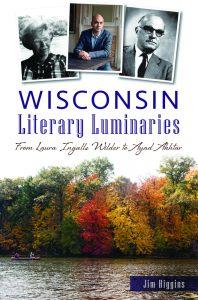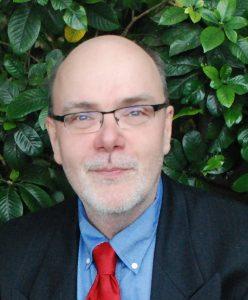Writers@Work: An Interview with Jim Higgins
April 4, 2017
Note From Rochelle
Dear Readers,
This spring, I’m finding inspiration for writing from the work of other writers—and I’m delighted to share this with you! For today’s tip, I interviewed journalist Jim Higgins, author of the new book Wisconsin Literary Luminaries: From Laura Ingalls Wilder to Ayad Akhtar. Higgins will talk about his new book at Boswell Book Company in Milwaukee on Thursday, April 6 at 7:00 PM. If you live in the Milwaukee area—consider attending: this should be an inspiring evening!
Enjoy!
Rochelle
The Write Now! Coach

Writers@Work: An Interview with Jim Higgins by Rochelle Melander
 First, thank you for your book! Can you talk about how this project came about and tell us a bit about the book?
First, thank you for your book! Can you talk about how this project came about and tell us a bit about the book?
The History Press specializes in local and regional books. After THP published Tennessee Literary Luminaries, about writers from that state, an editor approached me about writing a similar book about Wisconsin writers. I looked through the Tennessee book and thought about what I liked in it and what I might do differently.
Before committing, I also talked with my friend Bobby Tanzilo, a Milwaukee writer who has written several local history books for THP. He reported a good experience with the publisher.
I wrote a proposal for THP on how I would approach this book. The publisher accepted it, so I had a little more than a year to research and write it, as well as find or take the necessary photos to accompany the text.
In Wisconsin Literary Luminaries I offer friendly essays about ten Wisconsin writers: Laura Ingalls Wilder, Aldo Leopold, Thornton Wilder, Lorine Niedecker, Cordwainer Smith, Ellen Raskin, Larry Watson, Jane Hamilton, Michael Perry and Ayad Akhtar.
THP asked me to write for recreational and pleasure readers, which I did. But I also kept in mind students who might turn to this book for a little more information or insight into what they were reading.
I will cheerfully stipulate to the book being idiosyncratic. Some essays concentrate on just a few books by the author, others are more comprehensive.
Can you talk about how you chose these ten writers?
I discuss this in my book’s introduction, which I wrote last, after finishing the chapters on individual authors.
THP books are concise: this one comes in about 36,000 words. I figured out early in the process that I would have room to write about 10 authors.
I made a list of the possible writers I might include, ones who were either born here or spent significant years here. In addition to other sources, I used the Wisconsin Writers Wall of Fame at Milwaukee’s Central Library as a starting point (and in homage, I write about that Wall in my book’s introduction).
To create a book I hoped would have value and shelf life, I decided to concentrate on literary and imaginative writers, as opposed to ones whose work is primarily biographical or historical. While I value those kinds of books, too, I wanted to explore writers worth knowing for their style and powers of imagination.
I felt I could say things worth saying about each of the ten writers I picked. As I note in my book’s introduction, other versions of this book with a different lineup of writers are possible.
My subjects can be separated into three groups. The two Wilders, Leopold and Niedecker are pillars of state literature. (And in Leopold’s case, I thought it important and worthwhile to talk about him as a writer as well as an ecological prophet.) Cordwainer Smith and Ellen Raskin are two wild talents from Milwaukee with strong cult followings, especially among other writers. Each of the four living writers has written at least one contemporary classic or major work that’s widely known and studied. Also, because my book is aimed primarily at Wisconsin readers, I picked living writers who either still reside here or return frequently.
My cluster of writers includes the major literary genres: fiction, essay, poetry and drama. They also include writing for children as well as adults. I liked the variety I ended up with.
Finally, practical considerations matter too. This is a black-and-white book. If inside color had been possible, I would have included Lois Ehlert, the wonderful picture book writer and illustrator from Milwaukee.
As a writer and avid reader, I recommend that writers read widely. In your work, you get an opportunity to read and write about writers a lot. Beyond the writers and books you need to cover for work, how do you choose books? And what books have been most influential to your work as a writer?
Beyond books that I write about for the Journal Sentinel, I follow my enthusiasms and discoveries wherever they lead me. Because I usually write about new books and their authors for the newspaper, I often find my pleasure reading in older books.
To steal a phrase from Beowulf, I believe everything I read helps fill the word-hoard I draw from as a writer. At different and overlapping points in my life, writers important to me have included Walt Whitman, James Joyce, Samuel Beckett, Flann O’Brien, Jorge Luis Borges, Lawrence Block, Nancy Kress, James White, Octavia E. Butler, Oliver Sacks, Ellis Peters, Dashiell Hammett and many more. I often choose science fiction and fantasy for my pure pleasure reading.

You have worked for the Journal Sentinel for a long time and no doubt, you’ve covered a lot of authors. What advice do you have for writers?
I have a bookcase full of books about writing that I’ve dipped into, read or reread over the years. Many have been helpful as much for general inspiration and the exhortation to persevere as for specific advice.
Before starting to write my book I made a point of rereading Kenneth Atchity’s A Writer’s Time for his tips on time management and organization for writers on a long project (in my case, a writer on a long project and a day job). I didn’t follow the actual system that Atchity outlines, but I took heart from a number of points he makes, including his reminder that the first time a person does anything tends to take a long time. The first chapter I wrote for my book seemed to take forever, because I tend to figure out what I think and what I am doing as I do it.
For inspiration I also recommend A. Scott Berg’s biography Max Perkins: Editor of Genius, which describes in loving detail how Perkins worked with Hemingway, Fitzgerald, Thomas Wolfe and many other literary and popular writers during his era as the go-to editor at Scribner’s.
When I interview writers for the Journal Sentinel, I often end the conversation by asking them if they have advice for younger writers. Just keep writing. Stick with it. They tell me variations on this over and over.
I will happily share a famous quote about writing projects that novelist E.L. Doctorow told the Paris Review in an Art of Fiction interview: “I tell them it’s like driving a car at night: you never see further than your headlights, but you can make the whole trip that way.”
What are you reading now?
I just finished reading Live and Let Live by Evelyn M. Perry, a sociological study of Milwaukee’s Riverwest neighborhood that tries to explain how it has lasted so long as a multiracial, multiethnic community.
I like to have a long book going through the whole year. In 2016 I read the Bible from Genesis to Revelation. This year, I am reading The Complete Essays of Montaigne in the Penguin paperback (more than 1300 pages). I struggled my way through the smart but very dense scholarly Introduction, half worried the whole book would be like that. But Montaigne himself is highly readable and a friendly voice.
 Jim Higgins writes and edits stories about books, the performing arts, and other subjects for the Milwaukee Journal Sentinel. He has reported for the Journal Sentinel and predecessor Milwaukee Sentinel since 1983. He is a graduate of Marquette University and lives in Milwaukee County with his spouse, daughter, son, dog, two cats, and too many books to count.
Jim Higgins writes and edits stories about books, the performing arts, and other subjects for the Milwaukee Journal Sentinel. He has reported for the Journal Sentinel and predecessor Milwaukee Sentinel since 1983. He is a graduate of Marquette University and lives in Milwaukee County with his spouse, daughter, son, dog, two cats, and too many books to count.









Fascinating piece about the thought-process behind the choices made by a thoughtful and articulate writer and reader. Although not from Wisconsin, the collection includes many writers I have turned to again and again.
Thanks, Laurie!